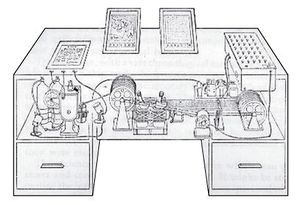More actions
m Added to goals. |
m Title to huge. |
||
| Line 1: | Line 1: | ||
{{4460f19|This=6}} | {{4460f19|This=6}} | ||
{{ | {{Huge|Foundations}}<br />{{small|August 26–September 6}} | ||
{{goal|title=Goals|Explore the foundational thinkers of new media;|Reply to a classmate’s journal;|Learn and use references and links in new journal posts.}} | {{goal|title=Goals|Explore the foundational thinkers of new media;|Reply to a classmate’s journal;|Learn and use references and links in new journal posts.}} | ||
[[File:Memex.jpg|thumb|Vannevar Bush’s Memex.]] | [[File:Memex.jpg|thumb|Vannevar Bush’s Memex.]] | ||
Revision as of 13:11, 17 July 2019
| 85288 | nmac 4460.01 | Online | Fall, 2019 |
Foundations
August 26–September 6
Goals:
|

Welcome to lesson two. Here, we want to do some digging in history to find out where our current thinking about and operational models for new media came from. What was going on historically that precipitated the rise of information storing and accessing devices? Why were such machines theorized in the first place? How do we understand our relationship with machines and how did they change the way we see ourselves? What is the significance of medium on how we perceive and experience our reality?
We will also continue our work on Wikipedia by learning how to communicate with your colleagues and continuing to add to your journals.
Reply
Let’s begin where we left off in lesson one with Wikipedia. First, read this brief introduction to talk pages[1] and about sending notifications.[2] — which will be a common practice in our use of Wikipedia. You might bookmark these pages for reference.
Next, see the look at a couple of your classmates’ journal posts from lesson one; you may find them listed under the R2 tab above or off my talk page. You task here is to comment on, or reply to, the second post of two of your classmates’ journals using proper talk page conventions (including indentations and notifications).
How do we reply? Well, have a look at “Reply, Respond, Comment” for some general guidelines. In essence, you want to be positive, thoughtful, and critical. What did they miss? What might they consider further? What did you find in your research that could help in their understanding? The goal here is twofold:
- to build a sense of community through participation and
- to help each other construct real knowledge.[3]
Overly superlative and laudatory comments are not helpful, though they might make us feel good. You can be positive without saying “yeah, I agree 100%” or “this post is perfect” or something similar.
While it is technically true that our journals are not talk pages, we should use talk page conventions anytime we we post comments and replies. |
When you have written your reply, be sure you preview, correct any coding or writing mistakes, sign your comment, and save. These steps are crucial, including signing your posts. If you do not sign, any notifications you attempted will not work and you will not receive credit for your comment. Any sloppiness in writing, including typos, makes your classmate’s journal look bad. Try to be conscientious and careful whenever adding comments — or editing any Wikipedia page for that matter.
Tip: I have tried to make these directions as clear as possible. However, you can always get additional assistance on the class help page. That said, be patient, read carefully, and do not get frustrated. Just keep trying. |
Explore
The link above will take you to a bibliography of readings that are applicable to this lesson. Remember, that PDFs that aren’t directly linked may be found on the “NewMediaClass” volume on Google Drive.
Choose a couple of these articles to read and research, like Bush, Licklider, or Wiener (omit McLuhan, as we'll look at him below). You could begin with Wikipedia by reading about these theorists before beging reading their work, like this article on Vannevar Bush. You also might try YouTube, as they have many educational videos like this Memex animation or this one on Licklider and the creation of the Internet. Try to get a sense of what issues these thinkers were having and why they needed a device that could propel their thinking and research beyond what they currently used.
Journal Post 3
Resources to review for journal posts: “Writing in the Liberal Arts”; “Writing Top Ten”; “Editor’s Checklist”; Adding a reference. |
Write about what you discovered exploring some foundational thinkers. When writing (or to get you writing), you might consider these questions:
- What are some early attempts to conceive of an information device for a new age?
- Who was Charles Babbage and why is he important to new media?
- Bush discusses the limits of human language to “mechanization.” What does he mean, and how does he propose to solve them?
- What is the “memex”? Does it remind you of any current technology or how we think of information?
- What is Licklider’s main concern? Do others we read for this section share it?
- What is “symbiosis” and how is it important to Licklider’s argument?
- Wiener suggests that we are on the verge of a new industrial revolution — one that will have profound implications for us humans. What does he mean and what are some of the implications that he predicts? Are any coming true?
- What is a Turing universal machine?
- What does Engelbart mean by “augmenting human intelligence”? Is what he theorizes coming true today?
- How have these foundational thinkers influenced new media?
Cite sources correctly using footnoted references, and link to Wikipedia entries in the text of your post.[4] You should have a couple of both.
Remember, you must support your ideas with evidence. This practice is paramount in the liberal arts and on Wikipedia. Remember Hitchens’ Razor:
| “ | That which can be asserted without evidence can be dismissed without evidence. | ” |
| — Christopher Hitchens[5] | ||
While your ideas are important and should be the primary focus of your journal, any assertions you make need the support of a secondary source. Begin practicing that now and in all your writing. Journal posts without support will never receive a grade higher than a C.
Marshall McLuhan
One of the most important foundational thinkers is the media theorist Marshall McLuhan, author of the seminal Understanding Media (1964). His deceptively simple statement “the medium is the message” has confounded college students for decades, yet it’s important that we grasp what he means and its implications.
Start here by reading “The Medium Is the Message” (PDF![]() ). Supplement your reading with a bit of research on this chapter. Again, YouTube has many videos on McLuhan, like this one that summarizes his key ideas. You might have a look at the other PDFs I’ve made available to you, like “The Gadget Lover: Narcissus as Narcosis,” or some of the writing I have on this site about his work.
). Supplement your reading with a bit of research on this chapter. Again, YouTube has many videos on McLuhan, like this one that summarizes his key ideas. You might have a look at the other PDFs I’ve made available to you, like “The Gadget Lover: Narcissus as Narcosis,” or some of the writing I have on this site about his work.
Journal Post 4
This post should be about McLuhan in some way. You might briefly interpret McLuhan’s main points or help clarify a particularly difficult one from research you’ve found. You might consider how McLuhan’s ideas relate to our digital lives, specifically. Or, more creative types, could pick a medium and analyze its message. Remember to cite and link correctly.
Reply to at east one of your colleagues’ journal posts for this lesson.
Due Date
Please have all of the above completed by Sunday, September 8, 2019. I will evaluate your this lesson the following day, email everyone a progress report, and post audio feedback at the top of the next lesson if necessary.
Tips:
|
Notes
- ↑ Several similar pages exist on Wikipedia, like Talk Page Help or this talk page tutorial. You could also do a Google search for more, if necessary.
- ↑ You might also have a look at the various ways to use
{{Reply to}} - ↑ I could also add: it helps us practice our talk page discussion conventions.
- ↑ External sources are always footnoted as references; Wikipedia entries are always just linked in the text. Never cite a Wikipedia article like you would an external source.
- ↑ Hitchens, Christopher (October 20, 2003). "Mommie Dearest". Slate. Retrieved 2016-04-24.
